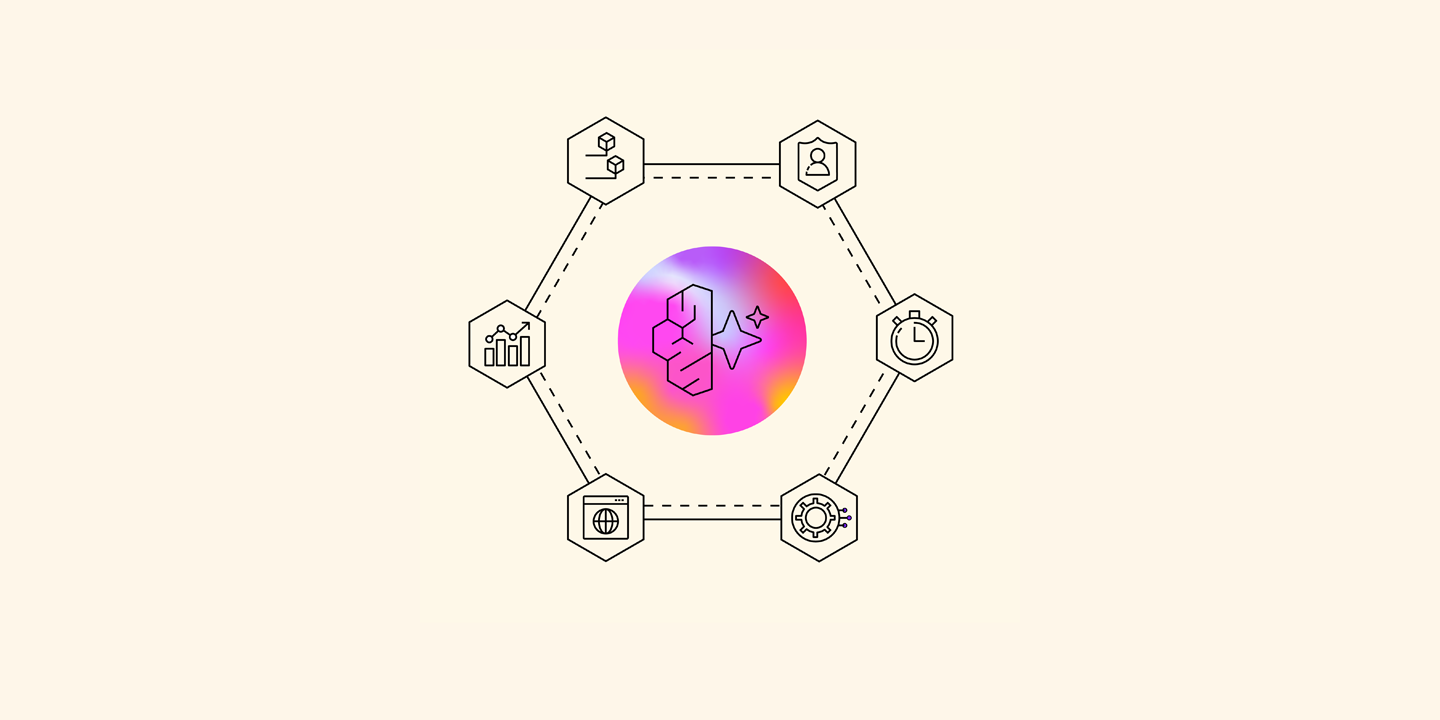- AWS Executive Insights›
- AI-ML›
- Agents vs. Automation
AI Agents vs. Automation: A Leader’s Guide to Understanding the Difference & Choosing the Right Solution
The difference between automation and AI agents:
Automation follows a set of predefined rules to complete tasks—fast, consistent, and predictable. AI agents, on the other hand, operate with autonomy: they can reason, adapt, and make decisions based on dynamic inputs. The more autonomy a system has, the more flexible—and complex—it becomes to manage.
The term "AI agent" has become a catch-all label for everything from simple chatbots to complex, autonomous, self-directed systems. But not every intelligent tool qualifies as an actual agent. For business leaders, the real question is: When do you need a truly autonomous AI agent, and when is advanced automation enough? The answer has major implications for ROI, implementation complexity, and long-term governance. Choosing the right tool means balancing business needs, technical capabilities, and organizational readiness.

AWS Generative AI Innovation Center
The AWS Generative AI Innovation Center is a global team of science and strategy experts that turns AI into real business value. This includes supporting informed decision-making about implementation and when to leverage agents. This article offers guidance from the Generative AI Innovation Center to help your teams:
- Match business needs to the appropriate AI solution
- Distinguish between true agents and sophisticated automation tools
- Plan AI agent implementation strategy based on required autonomy levels and organizational readiness
- Create governance frameworks that align with solution complexity

The AI agent spectrum: From automation to autonomy
Consider agent autonomy on a spectrum – from simple scripts to independent systems. The key distinction lies in how these systems make decisions. True agents can be given a goal and asked to reason and adapt dynamically, while non-agent solutions follow predefined paths, even when powered by advanced AI.
While partially autonomous agents operate independently to achieve specified goals, adapting their tool usage and strategy as circumstances change, true agents represent a significant leap in capability. At the highest level, fully autonomous agents set their own objectives, create tools as needed, and learn from outcomes. This progression from strictly automation to autonomous decision-making defines the landscape leaders must navigate.

Decision framework: When to deploy AI agents
The key to successful AI implementation isn't about deploying the most advanced solution available – it's about selecting the right tool for your specific business challenge. Consider these four factors:
1
Autonomy requirements:
From basic Large Language Model (LLM) chains, which are non-agent solutions that follow a fixed sequence of AI operations, to fully autonomous agents, you can select the appropriate level of independence. The latter operates with minimal oversight, sets its own goals, and creates tools as needed. However, the freedom of a fully autonomous agent isn't always desirable or necessary. Learn more about the best use cases for autonomous agents in our case studies with HERE Technologies and Druva below.
2
Task complexity:
Advanced tools have made agents more accessible across industries, and their flexibility allows them to handle the most complex tasks (e.g. reasoning across multiple large data sets). The Generative AI Innovation Center’s best practice is to strive for the simplest solution that works, and critical applications that require absolute predictability may be better served by traditional automation.
3
Latency:
Agent operations require multiple API calls and reasoning steps, introducing significant latency compared to more basic automation. Time-critical applications may need alternative solutions if near real-time response is essential.
4
ROI considerations:
Evaluate your AI investment across cost savings, efficiency gains, and scalability potential. Consider the complete spending outlay across infrastructure (both capital and operational), inference, DevOps, human oversight, and usage. While incredibly efficient, multi-agent systems can multiply these costs 5-10x over more basic solutions.
Risk and governance considerations
While agents share some compliance requirements with other AI systems, their ability to make independent decisions demands additional oversight. To help illustrate this concept, think of it as the difference between managing a team of employees versus maintaining automated equipment - both need supervision, but in fundamentally different ways with fundamentally different needs.
Organizations should consider controls such as:
- Clear lines of responsibility: knowing who oversees each autonomous system
- Defined boundaries and secure access control: establishing clear limits for autonomous operations, including access to the appropriate data
- Human oversight to match the level of agent autonomy: more independence requires more sophisticated monitoring
- Identity and authorization processes: managing and verifying access to enterprise data and tools for agents to ensure security and accountability.
- Comprehensive audit trails for agent decisions and actions: understanding not just what happened, but why
While governance structures add to overhead costs, they are essential for long-term implementation planning. The level of oversight must scale with both task complexity and the degree of autonomy.

Real-world applications for agentic AI: From theory to practice
Two recent customer examples illustrate when an agent versus non-agent solution will meet the particular business need:
Streamlined processes: HERE Technologies
The Generative AI Innovation Center worked with HERE Technologies, a leader in location and mapping solutions, to develop an AI coding assistant that converts natural language into HTML and JavaScript code to help developers leverage the right APIs across their network. The team chose a more streamlined, sequential AI approach rather than autonomous agents for two key reasons: the need for consistent results and quick response times for providing coding suggestions to users.
The solution followed a fixed sequence using Amazon Bedrock: managing conversations, validating requests, finding relevant documentation, and generating code. This approach proved successful, achieving 87.5% accuracy with responses in under 23.5 seconds. This in turn reduced the time to onboard new coders and deliver new functionalities, demonstrating how structured approaches excel when processes need to be predictable and fast.

Complex decision-making: Druva
The Generative AI Innovation Center’s work with Druva, a data security leader, required a different approach. Druva’s challenge was to help customers identify and respond to data threats across their infrastructure – a task requiring constant monitoring and complex analysis.
Because each security threat might need a unique combination of responses, no single sequence of steps could address all scenarios. This required a system that could understand context and coordinate multiple specialized functions. With this multi-agent copilot, Druva aims to reduce the average time-to-resolution for data security issues by 70%, accelerate backup troubleshooting from hours to under 10 minutes, and enable customers to complete 90% of routine data protection tasks through natural language interactions within the next 12 months.

Finding the right use cases for agentic AI vs automation
Implementing agents requires balancing opportunity with practicality. Success comes from thoughtful integration that aligns with your business objectives and organizational readiness.
Start small, with focused implementations that allow your organization to learn and adapt. As teams gain experience and confidence, they can expand to more complex use cases while maintaining appropriate controls. Tools like Amazon Bedrock AgentCore can help organizations manage this transition, once the fundamentals are established: clear business objectives, appropriate governance, and measured implementation.
Not every AI solution needs to be - or should be - a fully autonomous agent. Sometimes a well-designed automation tool is the better choice. By understanding these distinctions and following a measured approach, leaders can implement solutions that meaningfully transform their operations while managing risks appropriately. This is why the Generative AI Innovation Center is passionate about ensuring customers are finding real business value from their AI solutions, agentic or otherwise.
